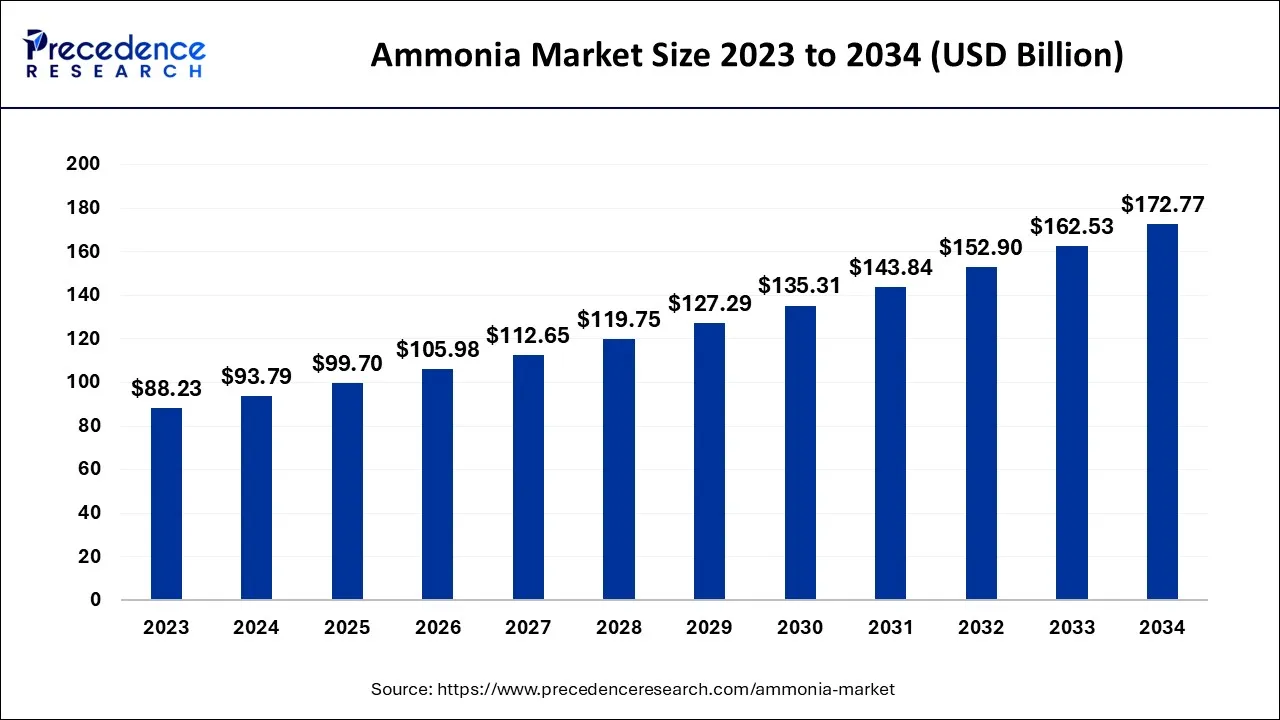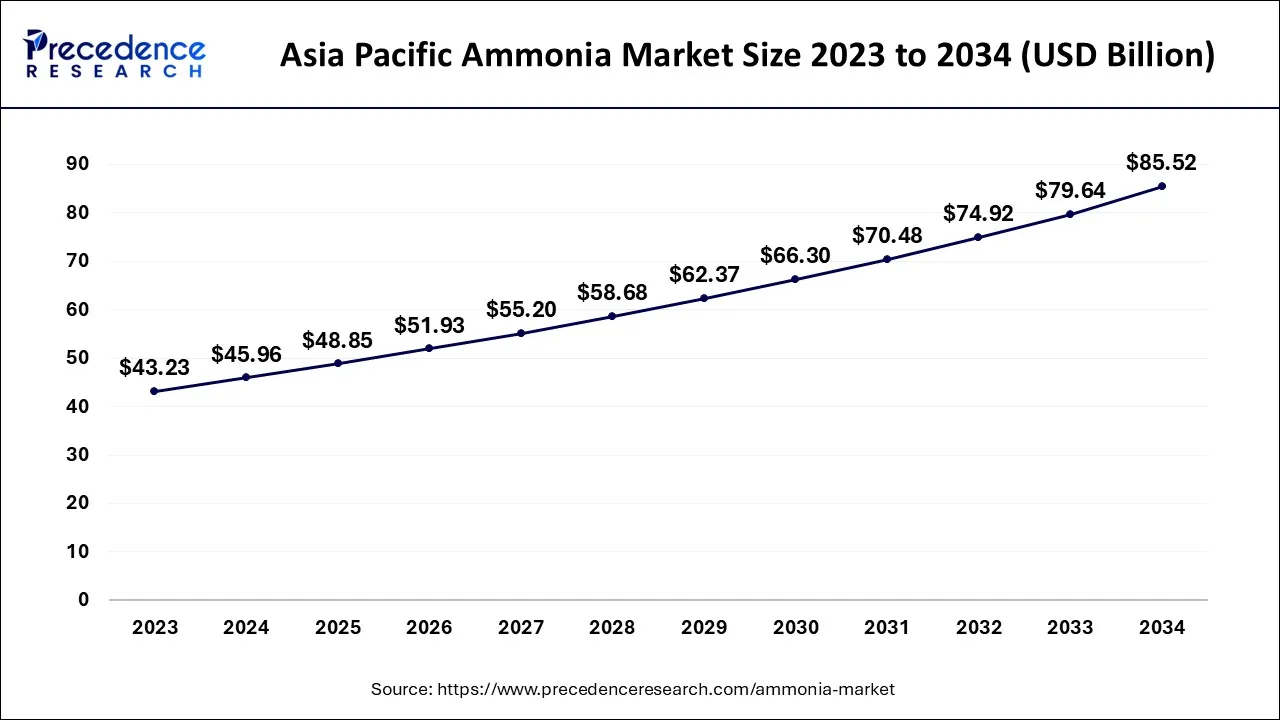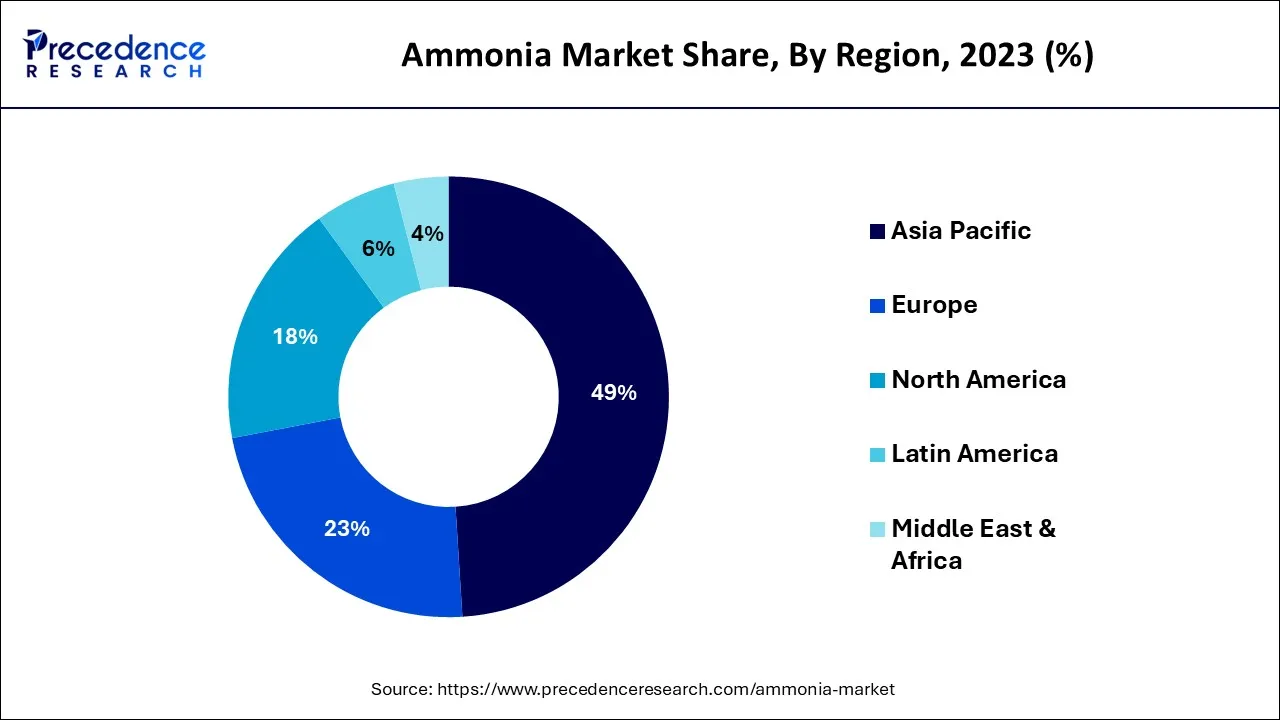Ammonia Market Size and Forecast 2025 to 2034
The global ammonia market size was calculated at USD 93.79 billion in 2024 and is anticipated to reach around USD 172.77 billion by 2034, growing at a CAGR of 6.3% over the forecast period from 2025 to 2034.

Ammonia Market Key Takeaways
- In terms of revenue, the market is valued at $99.7 billion in 2025.
- It is projected to reach $172.77 billion by 2034.
- The market is expected to grow at a CAGR of 6.30% from 2025 to 2034.
- Asia Pacific led the global market with the highest market share of 49% in 2024.
- The North America region is the world's second-largest production and user of this market.
- By product form, the liquid segment registered the maximum market share in 2024.
- By application, the fertilizers segment generated over 42% of revenue share in 2024.
Asia Pacific Ammonia Market Size and Growth 2025 to 2034
The Asia Pacific ammonia market size accounted for USD 48.85 billion in 2025 and is projected to be worth around USD 85.52 billion by 2034, poised to grow at a CAGR of 6.41% from 2025 to 2034.

The ammonium market in Asia-Pacific is acknowledged as being the world's largest and fastest expanding in the world. The existence of numerous international companies and the growing demands for agricultural goods in the area are both credited with this expansion. Leading nations in the country's ammonia sector are thought to be India and China. These nations, together with Indonesia, are contributing to the expansion of the ammonia market in the region. Prices have been consistently falling in the market over the last 2 years on a worldwide scale. The widening imbalance between the country's demand and supply is mostly to blame for this. The main cause of the particular market is the additional production as a result of increased production and decreased demand. Lower food and crop costs, dim financial outlooks, erratic power prices, and increasing competition are all factors contributing to this reduced demand. China is the world's top consumer and manufacturer of ammonia. China holds a share of the market of more than 50% in the Asia Pacific. The country's ongoing large-scale manufacturing and use of ammonium are what fuels the increase. China's production capability is expanding quickly as a result of the country's expanding industrial capacity. Such expansion strategies by Chinese businesses are probably going to help the ammonia industry expand over the projected timeframe.

The world's second-largest production and user of ammonium are North America. Ammonia's rise in the United States is being driven by the expansion of the region's finished sectors. Ammonia is mostly used as fertilizer in the agricultural business. In North America, the need for fertilizer is expanding as a result of the region's expanding population and the increasing demand for higher crop yields. The United States is one of the world's top ammonia manufacturers. About 45.50% of the output is utilized in the United States to make nitrogen fertilizer, with the remainder product being used to make synthetic textiles, polymers, resins, and numerous other chemical substances. Since natural gas makes up about 50.50% of the cost of producing fertilizers, its affordability in the nation is anticipated to be a key component in the country's industrial growth.
The fertilizer company's increasing need for ammonia is anticipated to spur industry expansion. The product serves as the foundation for the global nitrogen market. Ammonia is a gas that is colorless, extremely unpleasant, and has a pungent, choke-inducing stench. It creates a solution of ammonium hydroxide which dissolves readily in water. Burns and discomfort may result from the solution. The gas is easily squeezed, and under pressure, it turns into clear, colorless liquids. It is often carried as a compressed fluid in a cylindrical shape. It is also not very flammable, but when subjected to extreme heat, this could explode.
The nation is one of the main manufacturers of goods. Worldwide, it is projected that the product's demand-to-supply ratio would shift toward surplus because generation capacity continues to outstrip consumption, which hurts a negative impact on efficiency levels. This capacity expansion is primarily occurring in areas with low production costs and abundant natural gas supply, such as the Mideast and the United States. In addition, pharmaceutical companies use ammonia significantly to make pharmaceuticals.
Ammonia is a processing aid utilized in the production of a variety of products for fermenting and growth control systems in biotechnology. Ammonia which is extensively utilized in the pharmaceutical business is created when the gas version of ammonium is mixed with water. It is produced for sale using the Haber-Bosch method. Temperature increase, a catalyst, and hot temperatures are all present during the process, which involves a direct interaction between atomic hydrogen and nitrogen. The process can make use of a variety of catalytic materials, including aluminum oxide, magnesium oxide, and iron oxide. It is created in a lab setting by hydrolyzing a metal nitride.
What Are the Key Trends Driving Growth in the European Ammonia Market?
The European ammonia market is expected to witness significant growth over the forecast period. The stringent environmental policies in Europe are forcing manufacturers to invest in green ammonia projects to minimize the emission of carbon. The leading-edge production technologies make Europe a world leader in ammonia production. Such consistency in the growth of the market is supported by the existence of large manufacturers and constant innovation of eco-friendly procedures.
Germany dominates the European market for ammonia because it has a highly developed manufacturing infrastructure and an industrial base. The chemical sector in the country is well-developed, owing to massive investment in sustainable ammonia production. The focus of Germany on implementing the concept of environmental sustainability and transforming ammonia production to the use of green energy further reinforces its role as a significant market player, facilitating the overall rise of the European ammonia sector.
Ammonia Market Growth Factors
Globally expanding agricultural activity is the main factor boosting the ammonia market. To develop healthily, plants continually need the essential minerals potassium, calcium, nitrogen, magnesium, and sulfur. According to the kind, location, and structure of both plants, the proportion of these minerals varies from plant to plant. Ammonium is often employed as fertilizer because it is thought to be a notable supplier of these nutrients. In the United States, fertilizers accounted for 88% of all ammonia consumption in 2020, according to Mineral Commodity Profiles. This proportion is anticipated to increase over the next few years due to farmers' growing reliance on ammonia to produce excess crop yields.
The main nutrient that plants need to grow robust and increase crop output is nitrogen. Nitrogen, meanwhile, remains a gas and cannot be used for biological or chemical processes. By using the Haber-Bosch procedure, which pulls nitrogen from the atmosphere and transforms it into a solution that plants can ingest, ammonia is rendered useable. Ammonium, which can be used as a direct fertilizer for soil or converted into several Nitrogen fertilizers, is thought to contain a significant amount of nitrogen. Most of the time, ammonia is used as the liquid in each of the chemical's principal uses. Ammonia is among the materials that are essential in the textile industry. In the textile business, ammonia is primarily utilized as a finishing agent for cotton-based materials. Additionally, because ammonia is very soluble in all liquids, it can the ability to give fabric any color.
Over the upcoming years, the ammonium market is expected to grow due to rising textile product demand and government initiatives to boost the textile industry. The government has greatly regulated the usage of ammonia. Thus, the cost of ammonia compounds varies from one country to another due to the intricate production process. Additionally, the oversupply of ammonia producers is restricting the market's expansion. Despite what the manufacturers are capable of producing, they cannot. This aspect is causing pricing uncertainty and will probably slow the ammonia industry's growth during the anticipated time frame.
Market Scope
| Report Coverage | Details |
| Market Size in 2025 | USD 99.70 Billion |
| Market Size in 2024 | USD 93.79 Billion |
| Market Size by 2034 | USD 172.77 Billion |
| Growth Rate from 2025 to 2034 | CAGR of 6.3% |
| Largest Market | Asia-Pacific |
| Second Largest Market | North America |
| Base Year | 2024 |
| Forecast Period | 2025 to 2034 |
| Segments Covered | Product Form, Application, and Region |
| Regions Covered | North America, Europe, Asia-Pacific, Latin America and Middle East & Africa |
MarketDynamics
Drivers
- Ammonia use is being driven by the growing agricultural sector -The desire for crops to be produced in greater quantity, quality, and yield has resulted in significant expansion within the agricultural industry all over the world. Particularly in emerging economies, the agriculture industry makes a decent contribution to the GDP of a nation. Growing agriculture increases the demand for various agrochemicals like fertilizer, which in turn indirectly increases the demand for ammonia. Ammonia usage has risen due to the continually rising need for fertilizer, which would enhance the industry's value throughout the projection period. Furthermore, farmers will profit from government fertilizer subsidies, which will raise the need for ammonia regionally.
- The world's population is growing quickly -The fast growth and modernization of the worldwide agriculture sector have been the main drivers of ammonia industry growth. Farmers all around the world are being forced to substantially improve agricultural production to order to keep up with the rising demand for different kinds of grain and other commodities as a consequence of the world's largest population growth. This calls for a significant amount of premium fertilizer, that can only be made utilizing ammonia. Nowadays, 60% of the annual global ammonia production is used by the fertilizer sector.
Key Market Challenges
- Creating safer, higher-quality ammonia for usage around both people and animals -The production of better-quality ammonia which is safer to be used around people and animals, while also extending its applications and maintaining a competitive price level, maybe the biggest issues producers in the ammonia sector face.
- Demand-supply gap and excessive fertilizer use - In some areas, the demand for ammonia exceeds domestic output for a variety of uses. These areas consequently rely heavily on imports. North America must export ammonia to meet its consumption, which forces the region to deal with a variety of issues like price volatility and a lack of suppliers, which in turn limits the ammonia industry to a certain extent. Additionally, the quality of the soil has significantly declined worldwide effect of the extensive use of chemical pesticides and fertilizers. The market for natural fertilizer is rising as a result of the growing desire for sustainable agricultural performs that decrease dangerous production and carbon emissions.
Product Form Insights
In terms of product form, the product's water content dominated the marketplace. Throughout the projected timeframe, the ammonia market is anticipated to grow due to the increasing demand for the substance in end-use applications. The truest form of ammonia, dehydrated ammonia, is devoid of any water molecules. It is a noxious gas that emits choke-inducing vapors and is mostly used as fertilizer. When utilized as a food ingredient, it is compacted into a colorless, clear liquid. 3 sections of hydrogen and a component of nitrogen are used to make it. In its diluted state, the substance is easily used for commercial cleaning tasks and the creation and production of particular compounds.
The liquid form of ammonia is most frequently employed. Major applications include residential and commercial cleaning as well as fertilizers. It is condensed into a fluid and combined with various plant stimulants for use in fertilizer. It reacts with moisture content within the gas phase to produce fertilizer soil that is abundant in ammonia.
Application Insights
Fertilizers containing ammonia are largely utilized in the agriculture sector. With a 42% share of the market during 2024, the recommended fertilizer category dominated the worldwide market. It is regarded as a significant supply of nitrogen, that is crucial for plant growth. Additionally, it is employed in the production of several liquid fertilizer mixtures that include urea, aquatic ammonia, and ammonium salts. Due to its quick reactions with soil moisture, free hydrogen ions, organic matter, and silty clay, ammonia is frequently utilized in agricultural applications. The characteristics that improve the utilization of ammonium in the sector include infiltration rate, land quality & architecture, and method. Textiles, pharmaceuticals, domestic and industrial cleaning, food and drink, metallurgical operations, wastewater and water treatment, polymers, pulp, and paper, & leather are some more potential sectors. Due to its great efficiency, environmental friendliness, cost-effectiveness, lower pipe size, and superior heat transfer capabilities, ammonia is utilized as a refrigerator.
Ammonia cooling systems are a secure and ecological alternative in a world where energy usage methods are being prioritized. It is regarded to be the most environmentally benign coolant among renewable sources. It has no potential to warm the atmosphere or deplete the ozone layer. Compared to certain other chemical refrigeration systems, ammonium also has more efficient heat transfer characteristics. Due to the ability to use refrigerant technology in a shorter area for heat transfer plant building and systems, operational costs are reduced. The majority of ammonia's usage as a coolant is in large industrial and commercial settings.
Ammonia Market Companies
- Achema AB
- ACME Group
- ACRON
- Acron (Russia)
- AquaHydrex (US)
- BASF SE (Germany)
- CF Industries Holdings Inc. (US)
- China Petroleum & Chemical Corporation
- Electrochaea (Germany)
- Enter (Italy)
- ENGIE (France)
- EuroChem Group AG (Switzerland)
- EXTRON (Germany)
- Fertiglobe plc
- Green Hydrogen Systems (Denmark)
- Greenfield Nitrogen LLC
- Group DF (Ukraine)
- Haifa Chemicals Ltd.
- Haldor Topsoe (Denmark)
- Helm AG
- Hiringa Energy (New Zealand)
- Honeywell International
- Hydrogenics (Canada)
- Incitec Pivot Ltd
- Indian Farmers Fertiliser Cooperative Limited (India)
- ITM Power (UK)
- Jiangsu Huachang Chemical Co. Ltd.
- Koch Fertilizer, LLC (US)
- Linde Group
- Maire Tecnimont S.p.A.
- MAN, Energy Solutions (Germany)
- McPhy Energy (France)
- Mitsubishi Gas Chemical Co., Ltd.
- Nel Hydrogen (Norway)
- Nutrien Ltd. (Canada)
- OCI NV (Netherlands)
- Orica Limited (Australia)
- Ostchem Holding
- Potash Corp
- Praxair, Inc.
- Qatar Fertiliser Company (Qatar)
- Queensland Nitrates Pty Ltd (Australia)
- SABIC (Saudi Arabia)
- Siemens Energy (Germany)
- Starfire Energy (US)
- Sumitomo Chemical
- The Dow Chemical Company
- ThyssenKrupp AG (Germany)
- Togliattiazot (Russia)
- Trammo Inc
- Ube Industries
- Uniper (Germany)
- Uralchem JSC (Russia)
- Yara International (Norway)
Recent Developments
- In April 2024, JERA and CF Industries are considering a joint venture to develop a low-carbon ammonia production facility with a design capacity of 1.4 million metric tons. JERA is contemplating a potential 48% ownership in the undertaking and has stated its intention to source more than 500,000 metric tons of low-carbon ammonia each year, as a source for the low-carbon fuels that Japan necessitates.
(Source: https://ir.cfindustries.com) - In March 2024, Yara announced its partnership with GHC SAOC, a subsidiary of Acme Cleantech. This new partnership framework will see Acme supply Yara with ammonia, boosted by reduced CO2 emissions. The agreement included 100,000 tons per annum of renewable ammonia and is designed to expand with enough notice.
(Source: https://www.yara.com) - In December 2023, CF Industries Holdings Inc. completed its acquisition of clickable link in the file above, Incitec Pivot Limited's (IPL) Waggaman ammonia production facility for USD 1.675 billion. This acquisition added 880,000 tons of ammonia production per year to CF's existing capacity.
(Source: https://www.worldfertilizer.com) - In 2022, Thyssen Krupp Uhde USA as well as Bloom Energy will produce about 30,000 tonnes of greener ammonia annually at LSB Industries' facilities in Pryor, Oklahoma. LSB Businesses is a US fertilizer manufacturer. The engineering plan to transform a small percentage of Pryor's current conventional ammonium production into greener ammonia will be created by Thyssen Krupp Uhde.
- To find effective and scalable solutions for the manufacture of ecologically approachable ammonia in Iceland, Green Fuel & Haldor Topsoe signed a Memorandum of Agreement in April 2021. The arrangement aims to provide the two businesses the freedom to investigate greener ammonia commercial potential.
- Thanks to a collaboration with MAN Renewable Technologies, Hartmann Company, and Eastern Pacific Transport, OCI NV will now have developed a maritime supply chain and commercialized ammonia & methanol as potential future shipment biofuels by the end of March 2020.
- Industries At a conference on August 23, 2020, Qatar's Board of Directors endorsed the proposed acquisition of Qatar Petroleum's 25percentage shareholding in Qatar Fertilizer Company, according to the country, regarded as one of the region's major industries. In line with IQ's goal of increasing its downward position and generating wealth, the company has decided to purchase QP's shareholding in QAFCO.
Segments Covered in the Report
By Product Form
- Liquid
- Gas
- Powder
By Application
- Fertilizers
- Refrigerants
- Pharmaceuticals
- Textile
- Others
By Geography
- North America
- Europe
- Asia-Pacific
- Latin America
- Middle East & Africa (MEA)
For inquiries regarding discounts, bulk purchases, or customization requests, please contact us at sales@precedenceresearch.com
Frequently Asked Questions
Ask For Sample
No cookie-cutter, only authentic analysis – take the 1st step to become a Precedence Research client
 sales@precedenceresearch.com
sales@precedenceresearch.com
 +1 804-441-9344
+1 804-441-9344